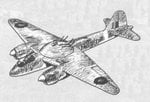kool kitty89
Senior Master Sergeant
That canopy design doesn't look like a fighter at all (maybe some lightweight fighter based on a trainer a/c), and the engine apears to be an air cooled inverted inline (Argus or Hirth) possibly a real a/c (or close to one) but not a fighter.
That canopy design isn't familiar though.
Here's a good reasourse LuftArchiv.de - Das Archiv der Deutschen Luftwaffe
I'll check a bit. (I beieve several bogus planes were used on the other Indiana Jones movies as well, so it wouldn't be surprising, but most of those resembled real a/c as well iirc)
Somewhat reminisant of the Ar 96 Arado Ar 96

That canopy design isn't familiar though.
Here's a good reasourse LuftArchiv.de - Das Archiv der Deutschen Luftwaffe
I'll check a bit. (I beieve several bogus planes were used on the other Indiana Jones movies as well, so it wouldn't be surprising, but most of those resembled real a/c as well iirc)
Somewhat reminisant of the Ar 96 Arado Ar 96











